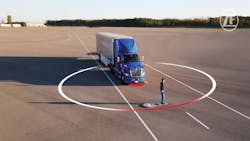When it comes to autonomous vehicles (AVs), the question isn’t if we’ll be sharing the road with them one day, but when. As it turns out, recent developments indicate that ‘when’ could be soon. Loadsmith recently purchased 800 trucks outfitted with Kodiak Driver, a long-haul self-driving vehicle system. In January, TuSimple also started testing its Level 4 autonomous trucks, which require no human interaction but can be overridden by a driver, in Japan. And Waymo and Aurora have been piloting their technology to deliver freight around Texas as well.
But before a significant number of AVs hit the road, the public must trust they won’t malfunction and cause accidents. This is where automatic emergency braking systems (AEBs) come in.
These systems use radar, lidar, and cameras to detect objects in front of a vehicle, and if an object or vehicle is too close, the system takes proactive measures to avoid a collision. Because of the obvious safety benefits, they are growing in popularity among fleets.
See also: DOT moves to make AEB mandatory on all trucks
And, overall, AEBs have worked very well in terms of safety, with a 2020 report from the Federal Motor Carrier Safety Administration (FMCSA) predicting that if widely implemented, this technology could prevent 31% to 37% of heavy-vehicle front-to-rear crashes. In June, FMCSA proposed a rule that will require AEBs on all new Class 3-8 commercial vehicles. This could go into effect as early as 2027 for heavy-duty and medium-duty vehicles by 2028.
The National Highway Traffic Safety Administration (NHTSA) estimates the proposed rule would prevent 19,118 crashes, 155 fatalities, and 8,814 injuries per year. A 2022 NHTSA study found that vehicles equipped with AEB and forward-collision warning technologies cut crash frequency in half.
The rule also has gained the support of American Trucking Associations. “The trucking industry supports the use of proven safety technology like automatic emergency braking,” asserted Dan Horvath, ATA's VP of safety policy.
The reason so many groups are behind the technology is because it lessens the impact of human error.
“Humans are fallible. Sometimes truck drivers are distracted or fatigued,” noted Zach Cahalan, executive director of the Truck Safety Coalition. “AEB is effective even when humans make mistakes. This is a slam dunk for roadway safety.”
But that doesn’t mean that this technology cannot also make mistakes. Even though AEB is generally proven to be safe and reduce accidents on the road, at times the technology can act unpredictably.
NHTSA has investigated complaints of AEBs exhibiting ‘phantom braking,’ or incidents where the system brakes hard, without warning, and seemingly at random. When FleetOwner affiliate Fleet Maintenance reached out to AEB manufacturers to discuss this phenomenon, none wished to comment on the matter
While OEMs and fleet leadership tout the safety benefits of AEB, intermittent issues such as phantom braking can put a wedge between fleet management and drivers.
“Fleets need to take driver complaints about these systems very seriously because they can cause a lot of issues,” said Daryl Bear, COO and lead engineer of Mesilla Valley Transportation Solutions (MVTS).
Though safety and trucking organizations agree that AEBs are successful and should be mandated, drivers and testing facilities aren’t convinced. This makes it all the more important to explore these systems, how to service them, and where they need to improve.
How AEB works
At its highest level, an AEB system is meant to account for human limitations. For instance, if a driver is distracted or has trouble seeing a vehicle ahead, the AEB provides an alert, a feature that some fleets have found useful for training purposes.
“The presence of automatic braking systems has increased driver awareness of their technique by alerting them to the reality of how close they are to an impending accident,” said James D. Moore, Ryder senior manager of technical maintenance support. “Over the course of a long day and in all traffic and weather conditions, the automated systems provide 100% efficiency to allow safe operation, even when the conditions are challenging.”
AEBs do this by reducing the engine’s throttle, applying the engine retarder, and then partially or completely engaging a vehicle’s foundation brakes, all while providing the driver with a dashboard alert if it detects an impending collision. Some examples in use today include Bendix Wingman Fusion, Detroit Assurance, Volvo Active Driver Assist, and ZF OnGuardACTIVE. While they were developed with different manufacturers, all of these systems integrate with several parts of the vehicle, including the air lines, engines, transmissions, and brakes.
“When the AEB system determines it must override the operator and apply the brakes due to a safety concern, the system will communicate to the air brake valve and open it,” said Joe Kay, director of engineering, Cummins-Meritor. “This allows air to flow to the foundation brake, thus applying the brake.”
This air system engagement also requires deep connectivity between AEB systems, stability controls, and anti-lock braking systems for proper functionality.
“There is some deceleration tuning that occurs within the stability control system to compensate for differences in the foundation brake system, so OnGuard can request specific amounts of deceleration, and the stability control system does the rest,” said Chuck Brodie, field service team leader, CV Solutions, ZF. “After that, we have to work with the engine controller so that we can derate it during CMS events or control the torque when ACC needs to adjust for a slower lead vehicle.”
AEBs work similarly with the transmission, allowing the former to recognize when the latter shifts so it can compensate for neutral coast features.
AEBs and maintenance
Because this technology works with so many other systems in a truck, any technician working on or servicing AEBs must be prepared to use a holistic maintenance approach that takes this interconnectivity into account. However, many AEB providers have said that recalibrating and diagnosing these systems is usually not done by a technician, but by the system itself.
“For OnGuard, a simple road test is all that is needed to make sure everything is working correctly,” said Chuck Brodie, field service team leader, CV Solutions, ZF. “If there are any issues, the system sets fault codes and lets [technicians] know via the HMI.”
During a public road test, Brodie explained, OnGuard attunes itself to the traffic and roadside objects, aligning the radar.
Detroit Assurance works similarly, explained Len Copeland, Detroit Products marketing manager, Daimler Truck North America. During a technician road test, Copeland said that Detroit Assurance is “learning its location on the vehicle relative to the camera on the radar” in a calibration process that “happens almost automatically.”
If the road test fails, then the technician needs to inspect the radar bracket, which may be bent and need repairs, or the system cameras, which may be blocked. “Watch where people might naturally place their foot when tilting a hood so as to not damage the module,” warned James D. Moore, Ryder's senior manager of technical maintenance support. “Also ensure [that the radar] brackets are sturdy and not susceptible to vibration.”
Beyond these mechanical solutions, TJ Thomas, director of marketing and customer solutions at Bendix, did not recommend technicians test AEB functionality without the use of specialized testing equipment and a trained driver.
“Beyond that, drivers and technicians should follow the information on the vehicle dash or ACom PRO for further diagnosing, troubleshooting, or calibrating,” Thomas advised, referencing Bendix’s diagnostic software.
However, fleets utilizing AEBs have also noted that maintaining these systems requires extra care for a vehicle’s electrical connections.
“It’s critical to focus on wiring integrity and connections,” Ryder’s Moore emphasized. “Pay close attention to wiring connectors, and protect them from corrosion and damage.”
This originally appeared in Fleet Maintenance, a sister site of FleetOwner.
About the Author
Alex Keenan
Alex Keenan has been associate editor for Endeavor's Commercial Vehicle Group, which includes FleetOwner magazine, since 2022. She has written on a variety of topics for the past several years and recently joined the transportation industry, reviewing content covering technician challenges and breaking industry news. She holds a bachelor's degree in English from Colorado State University in Fort Collins, Colorado.


